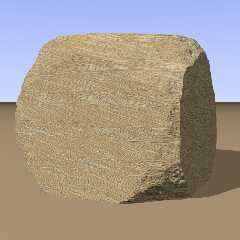|
 |
Op 23-9-2023 om 01:08 schreef Samuel B.:
> Thomas de Groot <tho### [at] degroot org> wrote:
>> Following the discussion p.a-u on how to generate sediment layering
>> without immediately requiring the use of isosurfaces, I have been
>> playing a bit with different ideas.
>>
>> First, in order to focus on something tangible, I got two Real World
>> examples:
>> https://geologylearn.blogspot.com/2015/11/sedimentary-structures.html
>>
https://blogs.egu.eu/divisions/ts/2019/12/27/features-from-the-field-bedding-stratification/
>>
>> Then, I used Gimp to draw a rough b/w image. This image I loaded into
>> GeoControl, my old heightfield generator, and exported a .tga image_map
>> that I could use as height_field in POV.
>>
>> A tentative result is attached here. Not bad for a first,I think. :-)
>>
>> Note: Jaime Vives Piqueres is the author of hf2iso. I can recommend it
>> if you want to play with isosurface landscapes.
>>
>> --
>> Thomas
>
> It looks very promising, Thomas! Any idea yet how you would go about
> constructing an entire feature (e.g. cliffside in a landscape)?
>
Thanks Sam. It is very preliminary still. I have not yet thought about
implementing this into a fully-fledged height_field/landscape, and
possibly this is going to be difficult.
While digging through my archives I came across a couple of macros I
wrote back in 2006, inspired by textures devised by PM 2Ring (see:
https://news.povray.org/povray.binaries.images/thread/%3C4458a6b4%40news.povray.org%3E/),
and forgot about. I may need to revise them a bit but they render as the
attached images.
However, they are still available here:
https://news.povray.org/povray.binaries.scene-files/thread/%3C44649a96%40news.povray.org%3E/?ttop=441393&toff=500
https://news.povray.org/povray.binaries.scene-files/thread/%3C4461eb1f%40news.povray.org%3E/?ttop=441393&toff=500
https://news.povray.org/povray.binaries.scene-files/thread/%3C446841e1%40news.povray.org%3E/?ttop=441393&toff=500
> The links you posted are quite inspiring. The first image in the first link is
> something I've tried to do, but always seem to fail at. Later on that page, I
> was amazed to see that sand ripples could be captured in such a way.
>
Yes, amazing, isn't it? Those things are what have always attracted me
in sedimentary geology. And to realise that those same features can also
be found as far back as deep into the Precambrian, more than 4 billion
years ago, before even life took hold on this planet...
> Ultimately, nothing will beat a full 3d simulation using voxels or similar, but
> who's got the hardware for that? (Or the algorithms? ;P)
>
Good question...
> Btw, they mentioned Zion National Park. Did you ever get to go there? I was
> there when I was six, on a road trip my dad took us on when following a
> meandering path to Montana. Zion was my favorite out of all the places we
> visited. The reddish cliffs were pure eye candy. I was hoping to see some desert
> sandstone plateaus, but we never passed through any such areas :(
>
Alas, I never visited that iconic site. The cliffs are textbook examples
of a diversity of ancient environments. Something for another life! :-)
--
Thomas org> wrote:
>> Following the discussion p.a-u on how to generate sediment layering
>> without immediately requiring the use of isosurfaces, I have been
>> playing a bit with different ideas.
>>
>> First, in order to focus on something tangible, I got two Real World
>> examples:
>> https://geologylearn.blogspot.com/2015/11/sedimentary-structures.html
>>
https://blogs.egu.eu/divisions/ts/2019/12/27/features-from-the-field-bedding-stratification/
>>
>> Then, I used Gimp to draw a rough b/w image. This image I loaded into
>> GeoControl, my old heightfield generator, and exported a .tga image_map
>> that I could use as height_field in POV.
>>
>> A tentative result is attached here. Not bad for a first,I think. :-)
>>
>> Note: Jaime Vives Piqueres is the author of hf2iso. I can recommend it
>> if you want to play with isosurface landscapes.
>>
>> --
>> Thomas
>
> It looks very promising, Thomas! Any idea yet how you would go about
> constructing an entire feature (e.g. cliffside in a landscape)?
>
Thanks Sam. It is very preliminary still. I have not yet thought about
implementing this into a fully-fledged height_field/landscape, and
possibly this is going to be difficult.
While digging through my archives I came across a couple of macros I
wrote back in 2006, inspired by textures devised by PM 2Ring (see:
https://news.povray.org/povray.binaries.images/thread/%3C4458a6b4%40news.povray.org%3E/),
and forgot about. I may need to revise them a bit but they render as the
attached images.
However, they are still available here:
https://news.povray.org/povray.binaries.scene-files/thread/%3C44649a96%40news.povray.org%3E/?ttop=441393&toff=500
https://news.povray.org/povray.binaries.scene-files/thread/%3C4461eb1f%40news.povray.org%3E/?ttop=441393&toff=500
https://news.povray.org/povray.binaries.scene-files/thread/%3C446841e1%40news.povray.org%3E/?ttop=441393&toff=500
> The links you posted are quite inspiring. The first image in the first link is
> something I've tried to do, but always seem to fail at. Later on that page, I
> was amazed to see that sand ripples could be captured in such a way.
>
Yes, amazing, isn't it? Those things are what have always attracted me
in sedimentary geology. And to realise that those same features can also
be found as far back as deep into the Precambrian, more than 4 billion
years ago, before even life took hold on this planet...
> Ultimately, nothing will beat a full 3d simulation using voxels or similar, but
> who's got the hardware for that? (Or the algorithms? ;P)
>
Good question...
> Btw, they mentioned Zion National Park. Did you ever get to go there? I was
> there when I was six, on a road trip my dad took us on when following a
> meandering path to Montana. Zion was my favorite out of all the places we
> visited. The reddish cliffs were pure eye candy. I was hoping to see some desert
> sandstone plateaus, but we never passed through any such areas :(
>
Alas, I never visited that iconic site. The cliffs are textbook examples
of a diversity of ancient environments. Something for another life! :-)
--
Thomas
Post a reply to this message
Attachments:
Download 'cross-bedded sandstone.png' (479 KB)
Download 'sandstone2.png' (626 KB)
Preview of image 'cross-bedded sandstone.png'

Preview of image 'sandstone2.png'

|
 |




![]()